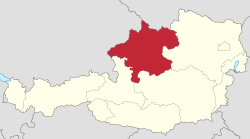Upper Austria
|
Upper Austria Oberösterreich |
|||
|---|---|---|---|
| State of Austria | |||
|
|||
 |
|||
| Country |
|
||
| Capital | Linz | ||
| Government | |||
| • Governor | Josef Pühringer (ÖVP) | ||
| • Vice-Governors |
|
||
| Area | |||
| • Total | 11,981.92 km2 (4,626.25 sq mi) | ||
| Population (14 June 2016) | |||
| • Total | 1,453,948 | ||
| • Density | 120/km2 (310/sq mi) | ||
| Time zone | CET (UTC+1) | ||
| • Summer (DST) | CEST (UTC+2) | ||
| ISO 3166 code | AT-4 | ||
| NUTS Region | AT3 | ||
| Votes in Bundesrat | 12 (of 62) | ||
| Website | www.land-oberoesterreich.gv.at | ||
Upper Austria (German: Oberösterreich, pronounced [ˈoːbɐˌʔøːstɐʀaɪ̯ç]; Austro-Bavarian: Obaöstarreich; Czech: Horní Rakousy) is one of the nine states or Bundesländer of Austria. Its capital is Linz. Upper Austria borders on Germany and the Czech Republic, as well as on the other Austrian states of Lower Austria, Styria, and Salzburg. With an area of 11,982 km2 (4,626 sq mi) and 1.437 million inhabitants, Upper Austria is the fourth-largest Austrian state by land area and the third-largest by population.
For a long period of the Middle Ages, much of what would become Upper Austria constituted , a region of the Duchy of Bavaria, while the area around Steyr was part of the Duchy of Styria (from which its name derives). In the mid 13th century it became known as the Principality above the Enns River (Fürstentum ob der Enns), this name being first recorded in 1264. (At the time, the term "Upper Austria" also included Tyrol and various scattered Habsburg possessions in South Germany.)
In 1490, the area was given a measure of independence within the Holy Roman Empire, with the status of a principality. By 1550, there was a Protestant majority. In 1564, Upper Austria, together with Lower Austria and the Bohemian territories, fell under Holy Roman Emperor Maximilian II.
...
Wikipedia


